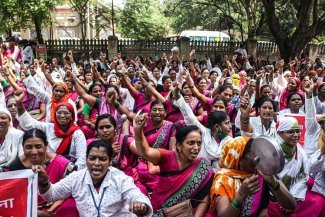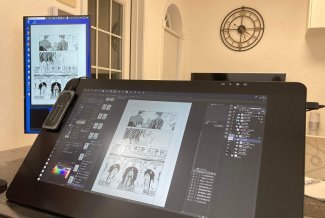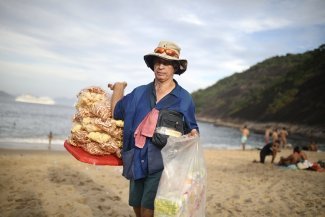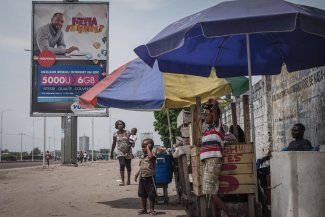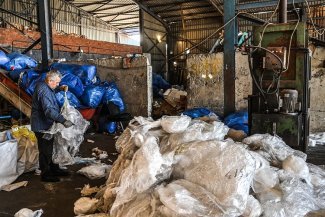Gaza city’s stifling feeling of being encased in an Israeli ring of fire dissipates for few moments as Mohamad Jabroq and I leave the port and setting sun behind, crashing through waves on his small, life-jacket-free motorboat fixed with floodlights to attract fish.
Tied in a line to three other boats, the lead vessel ferries the rest of us towards Israel’s three-mile siege line in a bid to save on high fuel costs.
However, the feeling of a rickety escape at sea is short lived and the reminder that Gaza is an enclosed ghetto with a salty swimming pool bursts through the air as the sound of Israeli machine gun fire directed at fisherman down the coast erupts.
As the rattling blasts from patrol boats continue, we edge towards Israel’s blockade line, and the fisherman in front of us cut their boats loose to cast their nets.
Gaza’s fishing economy has been decimated since Israel imposed a naval blockade restricting boats on the coastal strip to three nautical miles from shore following Hamas’s 2007 takeover. With only a few larger trolleys, these small boats are the maritime norm.
As a result, fisherman like Jabroq are forced into a life-threatening cat and mouse game with the Israeli navy in a bid to cope with the limited accessible fish and earn a dwindling day’s wage.
Things briefly improved following the ceasefire agreement from Israel’s November war which extended the blockade line to six nautical miles, reinvigorating one of Gaza’s main local industries.
However, fisherman say that all ended during President Barack Obama’s March visit to the region when – amidst US declarations of unwavering support for Israel and calls to restart negotiations –Israel violated the ceasefire agreement, again restricting Gaza boats to three miles.
At 47, Jabroq has seen it all in his 24 years on the sea. As he cuts his line from the boat in front of us and drops anchor at three miles, he first scans the open sea in search of naval threats.
While having avoided Israeli capture at sea since the siege began, he is nonetheless nervous, and the lanky mustached man stands at the front of the small boat recalling the day in 2006 that Israel jailed him and took his boat.
While the 1993 Oslo accords allocated Gazans the use of 20 nautical miles of coastal waters, Jabroq says he was confronted by the Israeli navy at the six mile line. It was the dying days of the second Intifada, and the siege measures that closed Gaza in 2007 were already beginning to take effect.
"They shot out my engine," Jabroq says somberly as he tosses a net into the sea. "Then, over a loudspeaker, they ordered me to strip completely naked and swim over to the patrol boat. When I reached them they arrested me and confiscated my boat." He spent three months in an Israeli jail before being returned to Gaza through the Erez checkpoint without his boat.
Like most Gaza fisherman, these days business is slow for Jabroq, and on many days he returns to port without any fish.
It’s the height of sardine season, and he swears the best fishing for sardines is around six miles out from shore and that Israel’s ceasefire violation took place just as the season got underway.
So he turns his floodlights on in a bid to attract as many of the tiny silver fish as possible.
He says the day before was a particularly good day, catching 135 US dollars-worth of the small fish – of which 100 went to petrol, but he usually only takes home between 10 and 27 to support a wife and kids.
As a result he says that like many of the fisherman, he is pushed into attempting to fish in Egyptian waters where there are 30 nautical miles of accessible Mediterranean sea.
However, that carries its own risks and Jabroq describes a venture requiring reliance on the good will of the Egyptian coast guard to turn a blind eye.
“If not, sometimes the Egyptians also shoot at us,” he adds in an exasperated tone. It’s a policy that mimics Egypt’s crackdown on the tunnel-smuggling trade in Rafah, of which Gazans are dependent for basic imports.
The lead boat that ferried us to sea reappears as Jabroq casts his last net and we haphazardly jump in with the help of the other fisherman.
They leave their boats at sea for several hours, only returning to collect them and inspect the content of their nets hours later.
Hamas doesn’t help
As the built-up shoreline of Gaza city reappears and we enter into port, the fishermen complain about how new Hamas regulations and taxes is making it difficult to even get to sea and attempt a day’s catch.
They note that things are so bad that there are even sardines from Egypt being brought to Gaza through the tunnels.
Whether on the few larger trolleys or the small motorboats, these grievances are echoed back in port. The fisherman have an incredible sense of pride in their work, and it seems like the only thing that keeps them at sea is the salt water in their veins, the few minutes of feeling free when all one can see around them is the sea and a blind faith that the next day will be better.
At the top of their concerns is the drastic change in their profits since the re-imposed pre-war fishing restriction and the increased control and bureaucracy Hamas is now putting on them.
“After the war we would make 2000 US dollars a day,” says Ahmed Saidi, 34, whose family has been fishing Gazan waters for generations and works on one of the few larger trolleys. “Now if we collect 137, it’s a good day,” he adds, sitting on the deck of old and worn ship as his cousins and he work on fixing part of the engine.
After fuel costs and dividing the profits, it means he often takes homes as little as eight dollars a day.
His cousin Ashraf, a scruffy man in his 30s, raises his head from the engine room to recall a similar experience of arrest as Jabroq experienced.
He discusses losing his small boat in 2008 and spending six months in an Israeli jail for fishing just shy of the three mile line. “In reality Israel tries to hold us to 2.5 miles and regularly goes after us when we go out further.”
Still, fishermen in port complain that alongside having their plight ignored by the international community, they lack any real measures for collective response.
While the Hamas government keeps a strict security presence in the port – police are everywhere, I’m under constant watch and in order to access the port and board any fishing vessels, I’m required to get official permission from the Ministry of Interior – many say it has been unable to secure any long-term improvements for them.
Can they take collective action?
As for their union, I’m told by numerous fishermen that they have no independent organization of their own and that their union is controlled by the Hamas government, doing little for them beyond replacing lost nets and public advocacy on their behalf.
In the heart of the small, picturesque yet rubble-strewn port in a state of semi-construction, just past the statue and Turkish flags dedicated to the international activists Israel killed during its 2010 raid on the Mavi Marmera Flotilla vessel, is the fishermen’s union office.
It is next door to the coast guard, and entering to meet with union president Nezar Ayash I find a Hamas policeman going through papers at the desk of the short, mustached mid-40s labour leader.
After the officer leaves, we start the interview, and Ayash contends that the union is completely independent and does all it can to collectively fight for its 4000 members.
In what sounds like a corporatist relationship, Ayash says the union provides a channel for workers to list their grievances to the government.
“The Hamas government helps as it can. It gives some money, especially money from the donor countries,” he says.
In terms of action against the siege and improving fishermen’s earnings or safety, he says there is little collective action his members can take and all he can do is speak with the press and meet with international dignitaries to advocate for his members rights.
Leaning back in his chair expressing frustration with the situation, he contends the real power to break the firewall locking Gaza in by sea and land is with the Americans, who are actively helping Israel isolate Gaza and break its fishing economy.
“The Americans agreed to the last war and Israel used American weapons to attack and kill Palestinians. Americans help Israel keep this siege going,” he says, adding “how can we stop that kind of power?”
Leaving the crowded port through the entrance checkpoint, I’m struck by how in a glance it gives a thinly veiled impression of a bustling maritime centre rather than a Gaza lifeline being strangled in silence by Israel as its workers are left without any coherent way to resist.
Walking up the hill towards the built-up downtown, I pass a pile of rubble that before November housed apartments and offices as a Hamas security vehicle passes me on the road.
The intended projected image of Hamas as a functioning government fighting to free its people melts away. The reality is that – cut off from the rest of Palestine and the world – Gazans are left to rely on a ghetto administration which maximizes its minimal power while maintaining the status quo.



